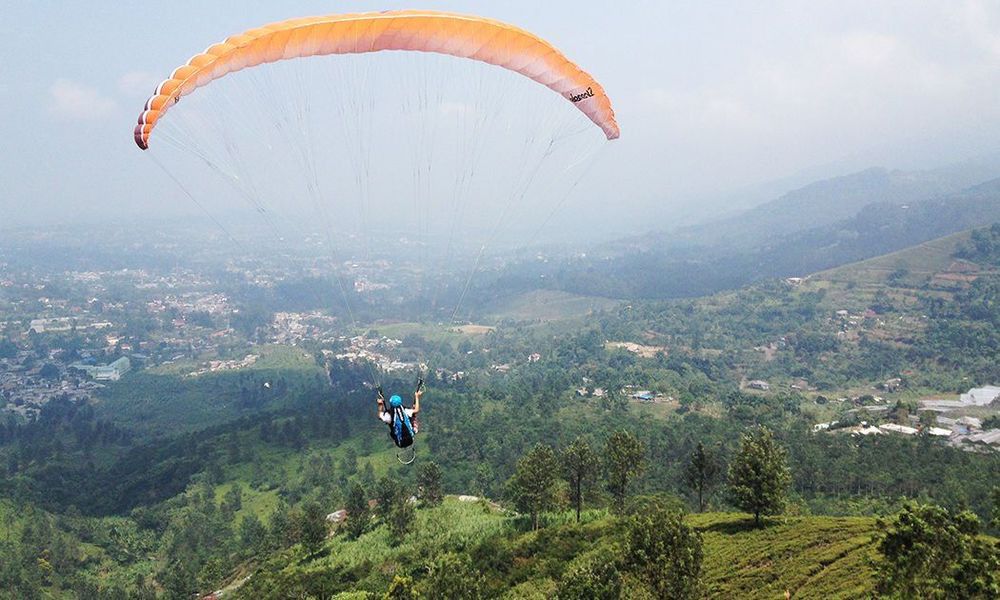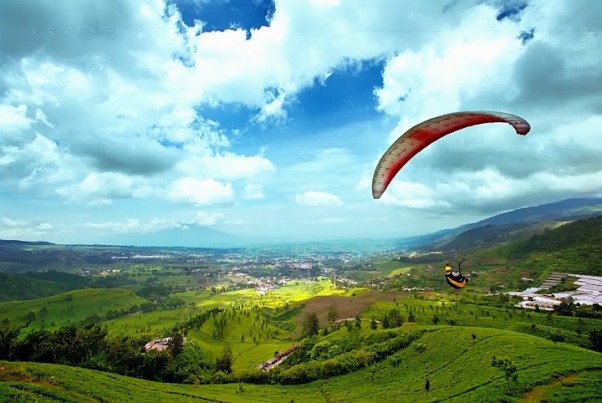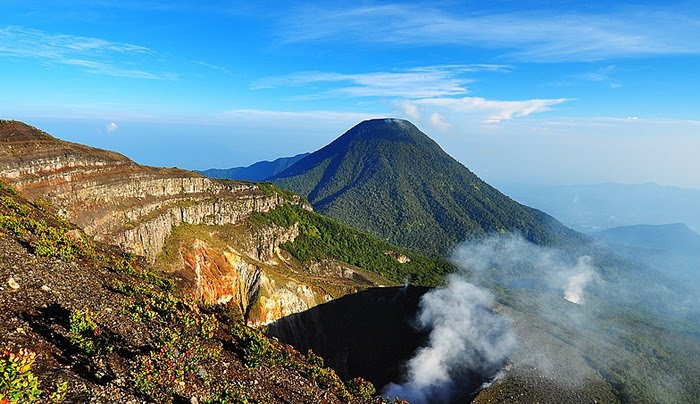Scuba diving
Starting just offshore and stretching away to the north is a string of classic coral atolls known as Pulau Seribu, the “Thousand Islands” (though in fact there are less than 200 of them). Each has a fringing coral reef, a necklace of white sand beach and a green, jungle-like interior. The closest ones are a little over an hour away from Jakarta by speedboat, and many of them now have resorts — you can choose from five-star luxury to budget bungalows. The water is clean and clear, the reefs are rich in corals and smaller fish, and there’s a good wreck to explore. Don’t expect a mind-blowing underwater experience, but when you add together the convenience, the idyllic above-the-water environment and the superb Jakarta-based dive operations that service the islands, you come out with a very good package.
Contact Dive schools in Jakarta
Surfing
A definite five-star rating here. Two hours in a car, or an hour-and-a-half in a high-powered speed boat, gets you to a series of world-class breaks that are relatively unknown, but currently on their way to becoming legendary. As with all Indonesian breaks, the swells come in from June to September.
Ombak Tujuh, a big peak similar to Sunset, is perfectly rideable at 7m and more, but usually cranks out a very manageable 2-4m wall. To get here drive south to Pelabuhanratu, then continue along the coast towards the Genteng Peninsula.
Panaitan Island’s horseshoe-shaped main bay has three epic waves, including the famous One Palm Point, a left that’s close to perfection but very intimidating. Crocs, a small peak, and Illusions, a smooth, middleweight right-hander, are far more user-friendly.
Deli Island is a clean, consistent right that’s very fast, very hollow and goes on for a long, long time. If you are a natural-footer, it’s manna from heaven.
Both Panaitan and Deli are zoned national parks, and have no accommodation. The most convenient way to get to them is by high-speed Sharkcat from Jakarta. You can stay overnight in the bungalows on nearby Pucang Island. Many surfing schools are there.
Hiking and exploring
Java is like a vast garden with different attractions on every corner. Hikers have an overwhelming choice, but the two destinations here, and a third in “Don’t miss this!” below, are among the best.
Ujung Kulon: Where to come if you want to spend a weekend acting out a Tarzan fetish. But don’t get too carried away: the beasts in this jungle really do bite. Ujung Kulon is a national park right in the southwest corner of Java. It’s not huge — about 75,000ha — but it’s located on a headland that’s only joined to the mainland by a very narrow isthmus. This natural restraint on access has kept the jungle environment amazingly intact, and the park is now the last refuge of many endangered species, including the Javan rhinoceros. You can spend a weekend here (there are bungalows on Peucang Island) but to fully appreciate it, you need at least a week. The park is maintained and run on admirably strict environmental principles, so enjoy it — and treat it with respect.
West coast and Krakatoa: This is a great getaway, but becoming a little too popular for it’s own good. The coast is surprisingly beautiful — palm trees, green hills, white sand and lots of reminders of the centuries of Dutch occupancy — and Carita is a great beach. Like most outdoor activities, it’s at its best in the dry months from April to November. You can also take a boat out to see Anak Krakatoa, a sinister, smouldering cone that’s risen from the vent of the great Krakatoa volcano. Anak Krakatoa is black, barren, hot, and stinks of sulphur. It’s also dangerous (some of the fumes it belches out will kill you in seconds). But, judging by its growing popularity as a tourist attraction, it has charisma.
Mountain biking
Mountain biking is already huge. Races attract thousands of competitors, and every Sunday the center of Jakarta is closed to let bikers of all pursuits cruise the streets. The locals are very friendly, and will give you plenty of good information, but watch the traffic: it’s unpredictable and terrifying.
Lido Lakes, a 700ha recreation site near Sukabumi, about 1hr 30mins from Jakarta, is a popular ride. The locals drive to the Lido Lakes Resort and set out on a circular route. It starts with an easy 6km uphill, runs along about 5km of rough track through a very pleasant pine forest, then finishes off with a long downhill that takes you through more forest, across bamboo river bridges and eventually brings you to the Sukabumi Main Road. Allow 3-4hrs for the ride. For more information, contact:
Rock climbing
Climbing is popular, and both skill and enthusiasm levels are very high. There are some excellent climbing venues within easy reach of Jakarta and you will find the locals warmly welcome visitors. Just don’t expect to impress them with your skill: it’s not uncommon here to see some unknown climber streaking effortlessly up a 5.13 route.
The best-known site is Chitatah, near Bandung. It’s a very rough slab, not high but with plenty of variety in the climbs. Routes range from 5.1 to 5.12 in difficulty. It’s popular, so you may be better off walking around to the “back” and trying your luck on the excellent Samur Wall.
The new hotspot is a place called Gunung Parang, just outside Cihuni village (near Plered) about 2hrs 30mins drive from Jakarta. Parang has three great towers. East Tower (250m) is scaled only by the most aggressive and skilled locals; Central Tower is nearly as tall, and has one 5.11 route that involves 12 heart-stopping pitches; and West Tower is broad and varied in its surface so there are lots of easier climbs here.
For more information, contact the Federasi Panjat Tebing Indonesia (Indonesian Rock Climbing Federation)
Paragliding
The sport has a good following. Many areas outside Jakarta are either hilly or downright mountainous, so there’s no shortage of potential launch sites. An area on the slopes of Gunung Mas — adjacent to a famous tea plantation of the same name — is currently the most popular. Views over the stunningly beautiful rural countryside of Java are a major plus, but problems with wind and rainy weather during the northeast monsoon (November-February) restrict flying to the months between March and October.
To get to the Gunung Mas site, go to Puncak, and then find Naringgul Village. The site is well known. (If you have problems, ask Anwar Permana at the Tea Plantation: he’s the site security officer for the Indonesian Paragliding Union.) A short ridge and wind speeds of 8-25 km/hr provide good lift. You launch from a prepared ramp, climb to about 300m, then pick up lift from a higher hill behind. The best flight path is to the south, towards Mounts Pangrango and Salak. Bogor City is visible in the distance.
For additional information, contact:
Fly Indonesia Paragliding, KP.Pensiunan No.80. RT/RW 001/001 Tugu Selatan – Cisarua. Bogor – Jawa Barat. Tel/WA: +62 851-7448-8998, +62 857-1828-3105
DON’T MISS THIS!
Hiking Gede-Pangrango National Park
This is the ultimate escape from Jakarta: nothing could be further removed from the sweaty, congested city streets than the cool peace of this beautiful mountainous forest reserve.
Mount Gede (2958m) and Mount Pangrango (3019) are the highest points in a great volcanic highland area immediately south of Jakarta. The soil here is extremely fertile, so the lower slopes are covered in vegetable gardens and tea plantations, but the Dutch recognized the unique beauty of the area and declared a large tract of it — 15,000ha, including the summits — a national park, so preserving the forest intact. The park entrance at Cibodas Gardens is a 2hr 30min drive from Jakarta. Look for the National Park Information Centre where you pay your Rp2500 entrance fee. The main trail starts right behind the information centre. There’s plenty to see and enjoy on a day-trip here, but if you want to reach either peak you have to make provisions for staying overnight on the mountain — either in a hut or camping in the fields. You’ll also need plenty of warm clothing and the services of a guide.
The Cibodas trail climbs quickly through tropical and sub-tropical forest, taking you past Blue Pool to the beautiful Cibeureum Falls. Another 2.5km up the trail is a gushing, sulphuric hot spring. If you are only here for the day, this is your return point. From now on, the sub-tropical vegetation starts to give way to montane forest, including alun alun, the Javanese edelweiss. There are basic huts at Kandang Batu (2200m) and Kandang Badak (2400m), or you can continue on to an alun alun field that is popular for camping. The trail forks at the second hut, branching left to the summit of Mount Gede or right to Mount Pangrango.
Either way, plan to make your final ascent before dawn. Not only do you get to enjoy the sunrise, the air is cleanest and you can see over the whole of west Java







